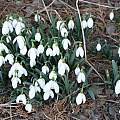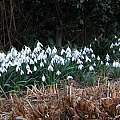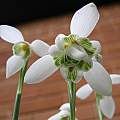On the legacy bulb wiki pages Kathleen Sayce reviews bulbs that outlast their gardeners, with some hints as to why. Suggestions came from PBS list members, review of world weed lists, USDA PLANTS National Database, Flora of North America, and some university databases. For more information consult Legacy Bulbs Index and Introduction.
Information about relevant Freesia through Hyacinthus species can be found on this wiki page. Information about other species is found on the pages linked below:
Albuca through Amaryllis - Anemone through Chionodoxa - Colchicum through Erythronium - Ipheion through Iris - Ixia through Lycoris - Merendera through Nerine - Ornithogalum through Sternbergia - Trillium through Zephyranthes
Ficaria verna, syn. Ranunculus ficaria, lesser celandine, has widely naturalized in North America (Northwest and Northeast) and is considered a noxious weed in many states. Its bright yellow flowers appear in early spring, marking the location, or near location of older homesteads; WHZ 4-9.
Freesia leichtlinii ssp. alba, white freesia, is a vigorous old garden inhabitant that prefers dry summers and excellent drainage, WHZ 9-11. In California, it persists in coastal areas.
Fritillaria is native to western North America and Eurasia, in summer dry to summer damp climates. It can be impressively fussy about drainage, and if it requires summer dormancy, it is essential to have a dry period at the right time. When required conditions are met, it can persist or naturalize easily, particularly European species in wet meadows, and western American species in dry summer climates. The following are European species that may persist in American gardens:
Fritillaria imperialis, Imperial lily, native from southern Turkey to Kashmir, also occasionally persists in suitable gardens, WHZ 4-7, preferring fertile, well-drained soils in the eastern half of North America.
Fritillaria meleagris, snake’s-head fritillary or checkered lily, is native from Europe to western Russia. This bulb prefers fertile well-drained soils and damp summers, WHZ 4-9, and may be successful in Eastern and Midwestern gardens with some summer rain.
Galanthus or snowdrops are cheerful midwinter blooming bulbs, with some species flowering in fall or spring. Galanthophiles avidly plant dozens of varieties with subtle variations in flowers, leaves and flowering time; generally thriving in WHZ 3-8. In partially shady, moist soils, but not wet, snowdrops may persist for decades or longer.
Galanthus elwesii, giant snowdrop, WHZ 3-9, is from the Levant, and flowers in late winter. Naturalized or persisting populations have been noted from Ohio to New York.
Galanthus nivalis, garden snowdrop, WHZ 2-9, flowers winter to early spring. This species may naturalize or persist more easily than others. Naturalized or persisting populations have been noted from Washington, Utah, and in eastern North America, from Ontario to North Carolina, and Newfoundland. A sterile form with doubled flowers (flore pleno) has been noted repeatedly as naturalizing; it spreads by bulbs, not seeds and is shown in the fourth photo.
Galanthus plicatus, Crimean snowdrop, flowers in winter.
Galanthus reginae-olgae flowers in autumn.
Hemerocallis species are hardy and easily grown in sunny to partly shady positions, with fertile, moist, well-drained soil. Terrestrial mollusks can be a problem, but these have not prevented this genus from establishing feral populations in WHZ 1-11. Flowers are edible when cooked, and plants are heat and drought tolerant. The following species were noted in the PLANTS database. As with other species, expect these and additional species to be established far more widely than is currently known.
Hemerocallis citrina, citron daylily, has lemon-flavored flowers, which are used in Chinese cuisine. It is from northeast China.
Hemerocallis dumortieri, Dumortier’s, or early daylily, is from Japan, Korea, Manchuria and eastern Siberia.
Hemerocallis fulva, orange, tawny, or ditch lily, grows in WHZ 4-9, and was spotted by Dennis Kramb in ditches in Ohio. It has been noted in most states and provinces, excepting a few southwestern states and California, and western Canada. It is native to Eurasia, from the Causcaus east to China, Korea, Japan and southeast Russia.
Hemerocallis lilioasphodelus, yellow or lemon daylily, has been noted in the Pacific Northwest, northern Midwest, Northeast, including Ontario and Quebec, and some southern states, and Texas. It was one of the first daylilies used for breeding. It is from northeastern China, Korea and eastern Siberia.
Hemerocallis middendorfii, Amur daylily, is cultivated for its edible flowers in Asia. It is from the Russian Far East, northwest China, Korea and Japan. It is hardy, WHZ 4-9.
Hemerocallis minor, small daylily, has been noted from Oregon. The species is native to northern China, Mongolia, Korea, and eastern Siberia.
Hesperantha coccinea, syn. Schizostylis coccinea, can be aggressive in gardens when presented with sufficient moisture and summer heat. It flowers in fall, with showy red or pink flowers; WHZ 6-10.
Hippeastrum is a genus of about 90 species and 600+ cultivars, native to tropical and subtropical Americas, from Argentina north to Mexico and the Caribbean. They can be grown outside in gardens in the southern US, with shelter from frost and rain, and are widely grown indoors in colder climates. Plants are mildly winter dormant, and may flower for months in well-established colonies.
Hippeastrum × johnsonii (Hippeastrum reginae × Hippeastrum vittatum), St Joseph’s lily, persists in suitably warm climates, WHZ 9-10. It is a traditional New Orleans pass-along plant, and is said to be the first Hippeastrum hybrid.
Hippeastrum puniceum, Barbados lily, grows in WHZ 8-11. Orange flowers, can naturalize in southern US gardens. Known to have naturalized in Louisiana.
Hippeastrum reginae, Mexican or ascension lily, has red flowers, and grows in WHZ 9-11.
Hippeastrum striatum, striped Barbados lily, grows in WHZ 8-11. Orange red flowers with yellow star centers. Known to have naturalized in Hawaii.
Hippeastrum vittatum, grows in WHZ 9-11. Large white flowers, striped with red, native to the Peruvian Andes.
Hyacinthoides is a small genus of European bulbs. Hybrids between species are common. This genus is widely naturalized in temperate growing areas of the world, and in North America is probably far more widely naturalized than is realized. This genus is commonly called squills, as are other members of the genus Scilla.
Hyacinthoides hispanica, Spanish bluebells, is native to the Iberian Peninsula. It has blue, white and pink flowers. A prolific seed setter, it has naturalized in the British Isles, other parts of Europe, and the Pacific Northwest including British Columbia, and Northeast US states, WHZ 4-8.
Hyacinthoides italica, Italian bluebells, is native to northeastern Spain, southern France and northwest Italy; WHZ 4-9.
Hyacinthoides × massartiana (Hyacinthoides hispanica × Hyacinthoides non-scripta), hybrid bluebell, when not called something profane, is a highly fertile hybrid that is considered invasive in the British Isles and temperate gardens in North America. Like Hyacinthoides hispanica, it has blue, white and pink flowers.
Hyacinthoides non-scripta, English or common bluebells, is endemic to Belgium, Great Britain, France, Ireland, the Netherlands, Spain and Portugal, and occurs as a naturalized species in Germany, Italy, and Romania, and in Pacific Northwest and Northeast parts of North America; WHZ 4-9.
Hyacinthus orientalis, common, garden or Dutch hyacinth, is native to southwestern Asia, in southern and central Turkey, northwestern Syria, Lebanon and northern Israel. It was introduced to Europe in the 16th century. Like many durable bulbs, it is poisonous. Naturalized populations are known in the US from Pennsylvania to Texas and California; WHZ 5-8 (9).
Species listed on other legacy bulb pages can be found alphabetically by clicking on the links below or by going to the index and introduction page where they will be listed in a table.
Albuca through Amaryllis - Anemone through Chionodoxa - Colchicum through Erythronium - Ipheion through Iris - Ixia through Lycoris - Merendera through Nerine - Ornithogalum through Sternbergia - Trillium through Zephyranthes - Legacy Bulbs Index and Introduction



















































